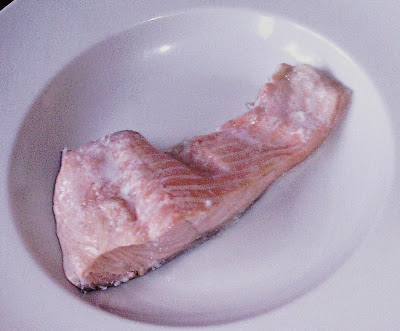 |
| Poached Scottish salmon potted in dill herb butter |
A few weeks ago, I saw a programme on TV about potted shrimps, showing the full process from catching the shrimps, to cooking them to potting them for eating. It reminded me of how I made several variations of jellied conger eel last summer to delicious effect and I got to wondering how I could use the general concept to come up with a Scottish version of potted shrimp using a typically Scottish fish/seafood. I did consider langoustines first of all but sadly couldn't get hold of any so I came up with the perhaps slightly unorthodox idea of using salmon. The results were as good as I could ever have hoped for and this is a concept I will be doing a lot of experimentation with in future.
 |
| Scottish salmon and flavourants ready for poaching |
Ingredients (Makes 4 Small Ramekins/Servings)
6 ounce Scottish salmon fillet, skin on
1/2 small white onion, peeled and sliced
1 bay leaf
6 to 8 whole black peppercorns
Salt
Combination of 2 parts water and 1 part white wine to fully cover salmon
*4 ounces/1 stick unsalted butter (do not use margarine or any other butter substitute)
1/2 teaspoon dried dill
White pepper
*It's very difficult to be precise with the amount of butter required as the size of the salmon flakes and the ramekins are variables. If in doubt, do prepare a little extra just in case. Alternatively, you can always prepare a little more immediately if you find yourself short.
 |
| Starting to poach Scottish salmon |
Directions
Add the salmon, onion, peppercorns and bay leaf to a pot just large enough to contain the fillet laid flat. Season with salt and pour in the water/wine combination. Put the pot on a medium to high heat. As soon as the liquid just begins to simmer, turn off the heat. Do not let the liquid boil. Move to a cool part of your hob, cover and leave to cool completely. The residual heat poaches the salmon to perfection.
 |
| Salmon is left to cool in poaching liquer |
When the salmon is completely cool, lift it from the water to a large plate.
 |
| Poached and cooled salmon |
The skin should easily peel from the salmon in one piece. Discard the skin and gently break the salmon in to moderately sized flakes with your fingers. Do use this opportunity to feel for and remove any bones which may remain.
 |
| Poached salmon is skinned and carefully flaked |
Divide the salmon flakes evenly between four small ramekins. Do not press down or overfill as the butter has to penetrate through and cover the salmon flakes.
 |
| Poached salmon flakes are added to ramekins |
Put the butter and dill in to a small saucepan, seasoning with a little white pepper. Put the pan on to a gentle heat, stirring regularly, until the butter is almost but not quite melted. Remove from the heat and gentle swirl until the butter is fully melted. This is to stop it splitting.
 |
| Butter is gently melted with dill and seasonings |
Pour the butter in to the ramekins to almost fill.
 |
| Melted butter is poured over salmon flakes |
Cover the ramekins and leave to cool and start to set. When cool, carefully transfer to the fridge and leave for a couple of hours to fully set. Overnight is fine.
 |
| Potted salmon is covered and left to cool |
Serving Suggestions
 |
| Potted salmon served with hot buttered toast |
There are a great many ways in which you can serve your potted salmon but it's worth remembering that unless you are serving it on something hot - like the toast in this first suggestion - you should take the ramekin(s) from the fridge about twenty minutes before serving to make it spreadable.
 |
| Potted salmon spread on hot toast |
The potted salmon is delicious simply spread on hot toast but a few thin slice of cucumber takes it to an even higher level.
 |
| Cucumber makes a very simple but tasty addition to potted salmon |
To make your dish really Scottish, oatcakes can be used to serve the potted salmon to equally delicious effect.
 |
| Potted salmon is also delicious with Scottish oatcakes |
No comments:
Post a Comment
Please not that all comments are subject to author approval before they will appear on this blog.